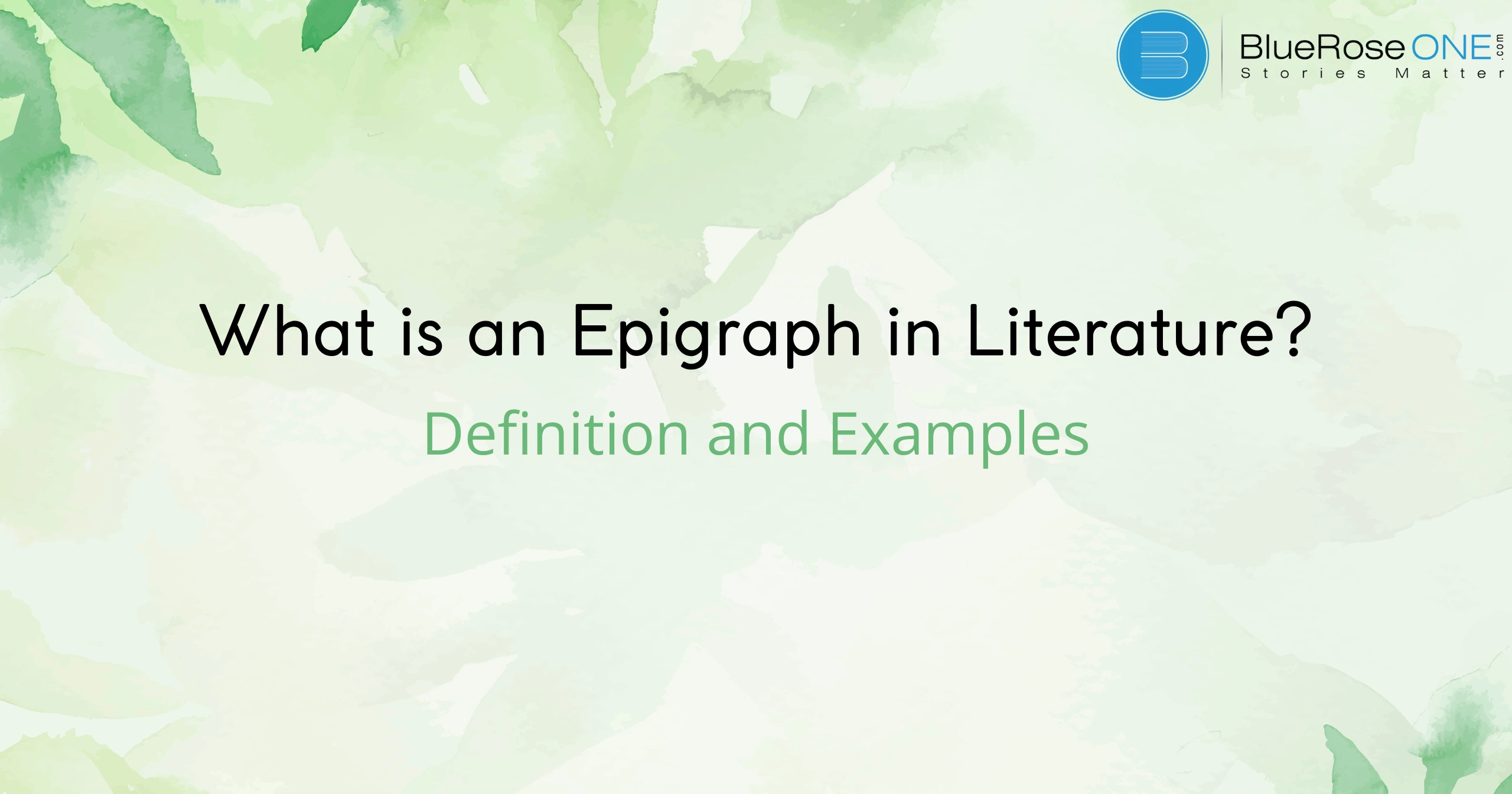What is an Epigraph?
An epigraph in literature is a brief quotation, phrase, or snippet that appears at the beginning of a book, chapter, or section. It frequently alludes to the theme or establishes the tone for the work to come. Epigraphs are used by authors to add background, pique the reader’s interest, or reveal the story’s deeper significance. For example, in F. Scott Fitzgerald’s The Great Gatsby, the epigraph echoes the novel’s themes of ambition and the pursuit of unreachable aspirations.
Epigraphs are more than just decorative; they reveal the author’s intent. They can set the scene, pique interest, or create a thematic resonance. For readers, an epigraph can feel like a secret handshake an intimate connection to the story that follows.
You may also read: Famous Author Who Used Pen Names (and Why They Did It)
How Epigraphs are Used in Literature
Setting the Tone of a Story
Epigraphs are an effective tool for establishing the tone of a story. They are frequently placed at the opening of a book or chapter and contain a quotation, poetry, or saying that alludes to the narrative’s topics or atmosphere.
Epigraphs generate a sense of anticipation by revealing the emotional or intellectual depth of the story. A haunting epigraph from a famous poet, for example, can set the tone for a story of mystery or tragedy, preparing readers for what is to come.
Highlighting Themes and Ideas
Epigraphs are frequently employed in literature to emphasize the primary themes or ideas of a work. Authors can establish the tone and steer readers towards the story’s deeper message by beginning each book or chapter with a brief, significant quote.
These lines might provide insight into the author’s inspiration, present crucial conflicts, or foreshadow the resolution. A well-chosen epigraph acts as a thematic compass, expanding the reader’s knowledge of the story.
Paying Tribute or Referencing Other Works
Epigraphs are frequently used to honor or acknowledge other works, writers, or ideas that influenced a work of literature. By using a quote or extract from another source, authors recognise their influences and establish a link between their work and the greater literary world.
This strategy not only honours the original author, but it also gives readers a better understanding of the topics or background that the writer intends to explore throughout the work.
Types of Epigraphs in Literature
Quotations as Epigraphs
Quotations are among the most common sorts of epigraphs in literature. These are frequently drawn from prominent authors, philosophers, or historical individuals to introduce a theme or establish the tone of the work.
Using a well-known quote allows writers to connect with readers while also adding context or insight into the tale. For example, an epigraph in a novel on perseverance could include a motivational quote that directs readers to the story’s fundamental message.
Original Writings as Epigraphs
Epigraphs are special since they are written directly by the book or story’s author. Instead of quoting someone else, the author creates a brief, compelling piece to establish the tone or emphasize the major idea of their work.
These personalized epigraphs can be poetic, introspective, or thought-provoking, giving readers an insight into the author’s mind. They also create a stronger connection between the story and its overall message, making the book feel more personal.
You may also like: List of 10 Best Libaries in Portsmouth for Book Lovers
Famous Examples of Epigraphs in Literature
Epigraphs in Classic Literature
- Mary Shelley’s Frankenstein: Quoting Paradise Lost by John Milton, the epigraph reflects themes of creation and rebellion.
- T.S. Eliot’s The Waste Land: The Latin and Greek epigraph sets an enigmatic tone for the poem.
Modern Works with Memorable Epigraphs
- Stephen King’s The Shining: Cites Edgar Allan Poe, enhancing the story’s chilling undertones.
- Donna Tartt’s The Secret History: Uses a line from Plato, underlining the philosophical depth of the narrative.
The Role of Epigraphs in Writing
Inspiring Writers and Readers
Epigraphs can inspire both writers and readers. For authors, selecting a meaningful epigraph can help set the tone for their story and direct their creative process. An epigraph provides readers with a starting point for understanding a book’s ideas or atmosphere.
Epigraphs, which are frequently based on famous phrases, poetry, or philosophical literature, serve to connect the work to larger ideas, promoting reflection and adding depth to the reading experience.
Enhancing the Reader's Experience
Epigraphs can improve the reader’s experience by setting the tone and adding depth before the main text begins. These brief statements or phrases, typically drawn from other works, might provide insight into the issues or ideas covered in the novel.
By including an epigraph at the start of a chapter or book, writers can discreetly direct the reader’s expectations or provoke contemplation. They provide levels of meaning by asking readers to consider the message or symbolism, making the reading experience more immersive and thought-provoking.
You may also like: What is a Preface? Key Characteristics with Examples
Tips for Writing an Epigraph
Choose a Relevant and Impactful Quote
When selecting a meaningful and striking quote for your epigraph, make sure it fits the themes or atmosphere of your work. The quote should be relevant to the fundamental idea of your work, giving readers a preview of what’s to follow.
The epigraph, which can be a passage from a poem, a historical figure, or a famous work, should be thought-provoking and set the tone. An effective epigraph enhances your writing by providing depth, context, or even foreshadowing key moments, thereby guiding the reader’s interpretation of the story.
Avoid Overuse of Epigraphs
While epigraphs might improve your writing, you should avoid using them excessively. Too many epigraphs might overwhelm the reader and detract from the main story. They should have a definite purpose, such as creating the tone or introducing a topic, rather than simply filling space. Using one or two properly selected epigraphs is frequently more effective than having several.
When used sparingly, epigraphs can have a greater impact, highlighting essential points or deepening the reader’s knowledge of your text. Remember, quality is more important than quantity.
Align the Epigraph with the Story’s Tone
When draughting an epigraph, make sure it fits the tone of your story. The epigraph establishes the tone before the reader delves into your story, therefore it should represent the emotions or themes explored in the book.
For example, if your narrative is dark or suspenseful, select an epigraph that evokes mystery or tension. A hopeful or appealing remark, on the other hand, might be appropriate for a light-hearted or romantic story. Aligning the epigraph with the tone of your work helps to establish a constant ambiance from the opening page.
You may also like: Top 10 Rhetorical Devices Every Writer Should Know
The Art of Interpreting Epigraphs
How Readers Can Decode Epigraphs
Epigraphs can be confusing, but readers can decipher them by focussing on a few essential elements. First, analyze the epigraph’s source, which may be a prominent author, philosopher, or historical figure, as this might provide context.
Next, consider how the quote relates to the story’s themes and characters. Sometimes the epigraph serves as a foreshadowing or reflection of what will happen in the story. Finally, reading the epigraph several times or in conjunction with the story’s significant events reveals its deeper significance and strengthens the overall message.
Appreciating the Subtle Layers They Add
Epigraphs frequently contain nuanced levels of meaning that can deepen the impact of a tale or poetry.
An epigraph introduces concepts or ideas that the book will explore by quoting a tiny paragraph, giving it a sense of richness.
These quotations can represent the author’s goal, providing insight into the piece’s emotional or intellectual context. Readers can appreciate these layers by thinking about how the epigraph ties to the text, which helps them better understand the narrative’s underlying message or tone. This gives depth and resonance to the overall piece.
Conclusion
Epigraphs are more than just literary flourishes; they are powerful links between the author, the text, and the reader. Epigraphs serve a unique function in the storytelling experience, inspiring, provoking thought, and evoking emotion.
Frequently Asked Questions
A good epigraph is concise, relevant to the text, and thought-provoking, sparking curiosity or offering insight.
No, not all books require an epigraph. It’s an optional creative choice that depends on the author’s intent.
Yes, many authors craft original epigraphs to introduce unique or personal perspectives.
An epigraph is a short quote at the beginning, while a preface is a longer introduction providing context for the work.
Epigraphs set a reflective tone, offering hints about the story’s themes and inviting readers to ponder their significance.
















